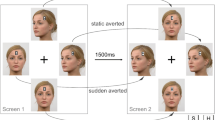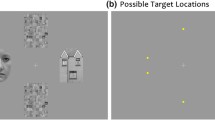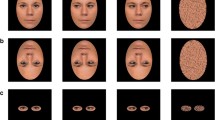Abstract
Reflexive attentional shift in response to another individual’s gaze direction has been reported, but it remains unknown whether this process can occur subliminally. We investigated this issue using facial stimuli consisting of drawings (Experiment 1) and photographs (Experiment 2). The gaze direction was expressed by the eye gaze direction (Experiment 1), and the eye gaze and head direction (Experiment 2). The gaze cue was presented either supraliminally or subliminally in the center of the visual field, before target presentation in the periphery. The task for participants was to localize the target as soon as possible. The reaction time needed to localize the target was consistently shorter for valid than invalid gaze cues for both types of gaze cues in both subliminal and supraliminal conditions. These findings indicate that attentional shift can be triggered even without awareness in response to another individual’s eye gaze or head direction.




Similar content being viewed by others
References
Adolphs R (2002) Neural systems for recognizing emotion. Curr Opin Neurobiol 12:169–177
Amaral DG, Price JL, Pitkanen A, Carmichael ST (1992) Anatomical organization of the primate amygdaloid complex. In: Aggleton JP (eds) The amygdala: neurobiological aspects of emotion, memory, and mental dysfunction. Wiley-Liss, New York, pp 1–66
Chance M (1962) An interpretation of some agonistic postures: the role of “cut-off” acts and postures. In: Symposia of the Zoological Society of London, No. 8. Evolutionary aspects of animal communication. Academic, London, pp 71–89
Danziger S, Kingstone A, Rafal RD (1998) Orienting to extinguished signals in hemispatial neglect. Psychol Sci 9:119–123
Driver J, Davis G, Ricciardelli P, Kidd P, Maxwell E, Baron-Cohen S (1999) Gaze perception triggers reflexive visuospatial orienting. Vis cogn 6:509–540
Esteves F, Öhman A (1993) Masking the face: recognition of emotional facial expressions as a function of the parameters of backward masking. Scand J Psychol 34:1–18
Friesen CK, Kingstone A (1998) The eyes have it! Reflexive orienting is triggered by nonpredictive gaze. Psychon Bull Rev 5:490–495
Friesen CK, Ristic J, Kingstone A (2004) Attentional effects of counterpredictive gaze and arrow cues. J Exp Psychol Hum Percept Perform 30:319–329
Hietanen JK (1999) Does your gaze direction and head orientation shift my visual attention? Neuroreport 10:3443–3447
Hoffman EA, Haxby JV (2000) Distinct representations of eye gaze and identity in the distributed human neural system for face perception. Nat Neurosci 3:80–84
Ivanoff J, Klein RM (2003) Orienting of attention without awareness is affected by measurement-induced attentional control settings. J Vis 3:32–40
Kendon A (1967) Some functions of gaze-direction in social interaction. Acta Psychol 26:22–63
Kentridge RW, Heywood CA, Weiskrantz L (1999a) Attention without awareness in blindsight. Proc R Soc Lond B Biol Sci 266:1805–1811
Kentridge RW, Heywood CA, Weiskrantz L (1999b) Effects of temporal cueing on residual visual discrimination in blindsight. Neuropsychologia 37:479–483
Kobayashi H, Kohshima S (2001) Evolution of the human eye as a device for communication. In: Matsuzawa T (ed) Primate origins of human cognition and behavior. Springer, New York, pp 383–401
Kubota Y, Sato W, Murai T, Toichi M, Ikeda A, Sengoku A (2000) Emotional cognition without awareness after unilateral temporal lobectomy in humans. J Neurosci 20:RC97:1–5
Langton SRH, Bruce V (1999) Reflexive visual orienting in response to the social attention of others. Vis cogn 6:541–567
Langton SRH, Watt RJ, Bruce V (2000) Do the eyes have it? Cues to the direction of social attention. Trends Cogn Sci 4:50–59
McCormick PA (1997) Orienting attention without awareness. J Exp Psychol Hum Percept Perform 23:168–180
Merikle PM, Reingold EM (1998) On demonstrating unconscious perception. J Exp Psychol Gen 127:304–310
Merikle PM, Smilek D, Eastwood JD (2001) Perception without awareness: perspectives from cognitive psychology. Cognition 79:115–134
Morris JS, Ohman A, Dolan RJ (1999) A subcortical pathway to the right amygdala mediating “unseen” fear. Proc Natl Acad Sci USA 96:1680–1685
Nummenmaa L, Hietanen JK (2006) Gaze distractors influence saccadic curvature: evidence for the role of the oculomotor system in gaze-cued orienting. Vision Res 46:3674–3680
Okada T, Sato W, Murai T, Kubota Y, Toichi M (2003) Eye gaze triggers visuospatial attentional shift in individuals with autism. Psychologia 46:246–254
Okada T, Sato W, Kubota Y, Usui K, Inoue Y, Murai T, Hayashi T, Toichi M (in press) Involvement of medial temporal structures in reflexive attentional shift by gaze. Soc Cogn Affect Neurosci
Posner MI (1980) Orienting of attention. Q J Exp Psychol 32:3–25
Ruz M, Lupianez J (2002) A review of attentional capture: on its automaticity and sensitivity to endogenous control. Psicologica 23:283–309
Sato W, Yoshikawa S, Kochiyama T, Matsumura M (2004) The amygdala processes the emotional significance of facial expressions: an fMRI investigation using the interaction between expression and face direction. Neuroimage 22:1006–1013
Tong F, Nakayama K, Vaughan JT, Kanwisher N (1998) Binocular rivalry and visual awareness in human extrastriate cortex. Neuron 21:753–759
Treisman AM, Kanwisher NG (1998) Perceiving visually presented objects: recognition, awareness, and modularity. Curr Opin Neurobiol 8:218–222
Vecera SP, Rizzo M (2006) Eye gaze does not produce reflexive shifts of attention: evidence from frontal-lobe damage. Neuropsychologia 44:150–159
Vuilleumier P (2002) Perceived gaze direction in faces and spatial attention: a study in patients with parietal damage and unilateral neglect. Neuropsychologia 40:1013–1026
Vuilleumier P, Schwartz S (2001) Beware and be aware: capture of spatial attention by fear-related stimuli in neglect. Neuroreport 12:1119–1122
Wiens S, Fransson P, Dietrich T, Lohmann P, Ingvar M, Öhman A (2004) Keeping it short: a comparison of methods for brief picture presentation. Psychol Sci 15:282–285
Acknowledgments
This study was supported by the Japan Society for the Promotion of Science.
Author information
Authors and Affiliations
Corresponding author
Rights and permissions
About this article
Cite this article
Sato, W., Okada, T. & Toichi, M. Attentional shift by gaze is triggered without awareness. Exp Brain Res 183, 87–94 (2007). https://doi.org/10.1007/s00221-007-1025-x
Received:
Accepted:
Published:
Issue Date:
DOI: https://doi.org/10.1007/s00221-007-1025-x




